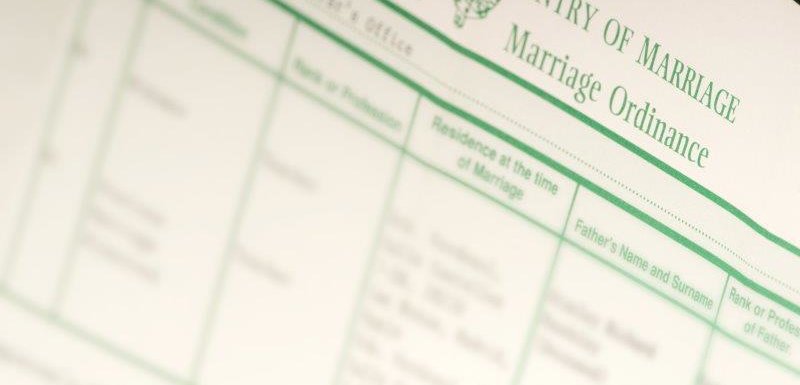
Registers of births, marriages and deaths
This page outlines how you can use the registers of births, marriages and deaths to assist you in performing a search for a birth relative
What does a GRO index reference number Look like?
Some things to consider when searching all the above registers
A quick methodology for searching
Where can I order certificates and access registers and reference numbers?
Are there any barriers to ordering certificates because I was in care?
Your parents’ birth certificates
Who holds the records?
The General Register Office (GRO) has all the records for birth, adoption, marriage, civil partnership and death registered for England and Wales from July 1837. These can be very useful in gathering more information and locating birth relatives.
Every birth, adoption, marriage, civil partnership or death registered in England or Wales has a GRO index reference number which usually consists of the year, volume number, page number and district in which the event was registered.
You can use this register to find your birth relatives’ record, such as their birth, marriage or death. Once you have the GRO index reference number, you will be able to order copies of the relevant certificates. Anyone can order a copy of any certificate for a fixed charge. You do not have to prove that you are related to the individuals concerned.
Often you can still order the certificates without the reference number if you have enough information but being able to quote this register number greatly reduces the cost and time it takes to find the record. If you ask the GRO to search on your behalf you should expect a surcharge and an increased waiting time.
What does a GRO index reference number look like?
The GRO Index Reference Number Typically consists of a “quarter”, a “year” a “District Volume” and a “Page” – for example ‘March 1954 2a 222’
After 1984 reference numbers do not contain a quarter.
Some things to consider when searching all the above registers
The registers contain the names of individuals as they were given at the time of registration. If your relative was known by another name, such as a middle name or a nickname, this may make it more difficult to find them. You can narrow your search to a list of the most likely candidates based on the surnames, dates and the locations of events.
Remember that a change of name has been possible by Statutory Declaration since 1835 or by Deed Poll, but this would not alter the entry in the Birth Register. There is no central register of deed poll name changes.
If the person you are seeking has had a gender change then a new birth certificate will have been issued. Although there is a Gender Recognition Register, this is a confidential link between the original and new birth certificates and is maintained by the GRO and is not open to the public.
A quick methodology for searching
Searching the registers is not an “A to B” process, and it may be that information you gain at one stage allows you to go back and consult another register with more information.
For this reason although we give a rough order for doing so we would recommend taking things slowly and keeping notes at every stage of the process, so that you can explore all the avenues open to you and return to previous registers if necessary,
Where can I order certificates and access registers and reference numbers?
To find out more about ordering certificates, as well as where you can find reference numbers visit https://www.gov.uk/research-family-history
There is a charge for ordering certificates, but since this can change we recommend researching this further on the site.
Please note that the physical microfiche records are the only full sets of reference numbers, and the free online resources listed on the GRO’s website may not be comprehensive up to the present day. There are a number of sites that offer the full indexes online as a chargeable service, such as ancestry research websites, that have more recent records, and we have collected a few here. Many libraries and archive services subscribe to these websites and allow patrons to access them free of charge. We recommend contacting your local library to find out if this is the case.
Are there any barriers to ordering certificates because I was in care?
Sadly because of measures to prevent identity theft the GRO has implemented measures such as needing the full date of birth, and the parent’s names before supplying the birth certificate if the certificate is less than 50 years old – which can be problematic for care leavers who want the certificate for exactly this information.
It is still possible to order certificates in these circumstances but you can’t do it online. Instead you will need to order by telephoning the GRO on 0300 123 1837.
If you encounter any problems you can tell the person you’re speaking to that the Births and Deaths Registration Act 1953 gives a statutory right to any birth certificate on payment of the appropriate fee.
NB: Please note that to order the certificate in this way you must have the GRO reference number from the GRO Index. (See above)
Looking for parents
Birth Certificates
Order your own birth certificate (if you don’t already have it) or the birth certificate of the person you are searching for as this will help you:
- Confirm the correct spellings of names
- Confirm dates of birth
- Give you the names of your/their parents and the address of where they were living at the time of the birth
This information can be useful when tracing other members of the family, such as brothers, sisters and grandparents.
Births are entered in the index when they were registered not when the birth took place. Although people are supposed to register a birth within 42 days this doesn’t always happen, so you should take care to check for the next quarter if you believe you know when the birth should have taken place when obtaining reference numbers.
The birth entry will give the child’s full name, the mother’s maiden name, the district where the birth was registered and the volume and page.
Examples of how these look can be found using this GRO guide.
Marriage certificates
Some care leavers will know their mother’s name but not their father’s, unless this has been recorded in their records. If you are looking for your mother, and she wasn’t married when you were born, you should start looking to see if she was married later.
Until recently it was usual for almost all married women to take their husband’s surname, so searching for marriage records can help you find out more about them, particularly their new surname.
There is no quick fix for searching for marriage records and this takes a lot of work. Start with the year and quarter you were born and keep a record of every entry of people with the same surname as your mother. This can be a huge and sometimes impossible task if your birth mother has a common name such as ‘Smith’.
Obviously depending on where your mother lived and her name, you may find quite a list of possible marriages, and no way of knowing which, if any, is that of your mother. You may get a clue from the area of the marriage, or the middle names or initials.
When you find a possible match the record will give you the following:
Names of persons married, District, Volume, Page
Now you know your birth father’s name, the same searching process can be applied for searching for a possible marriage for him.
Looking for adult siblings
If you are looking for an adult sibling, if you have their name and approximate age you can start by searching for their birth certificate. Again the same searching process will apply. Once you have found their birth certificate you can then check to see if they have been married. If they did, then a copy of the marriage certificate will give more up to date information about where your sibling lived at that time and any name change. This information may help you to locate their current whereabouts.
Deaths
When deaths are recorded a “qualified person” is required to register the death. This person’s full name, address and relationship to the deceased is given on the certificate and can be very useful. For instance if you had obtained your grandparent’s details using your parent’s birth certificates or marriage certificates and they had died, the “qualified person” may well be one of your parents, or an aunt or uncle. This will give you their address at the time the death was registered. Please note, however, that if no relative was available this “qualified person” may be a hospital administrator or care home staff member.
It may be that the combination of initials given is the same as your parents but not the surname. This may indicate a marriage, and can open up another avenue for you to pursue.
Wills
Once a death is found in the GRO indexes you can check the Principal Probate Registry online to see if the person died intestate. This means they died without having made a valid will. Although you will only find out the estate’s value and the people granted letters of administration you can order a copy of the probate records for a small fee. This document can include a lot of information – including the names and addresses of beneficiaries and possibly the name and address of a family solicitor. For further information about Probate and Wills, go to: www.gov.uk/wills-probate-inheritance/searching-for-probate-records.




